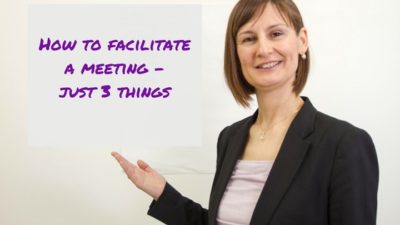Let’s make this easy. After all, the word “facilitate” comes from the Latin “facilis,” which means “easy.”
It’s the facilitator’s role to make it easy for participants to achieve the meeting goals.
Remembering just 3 things will make it easier for you to facilitate effectively.
This works for in-person meetings, telephone conference calls, and video conference calls. Use this with any number of meeting participants and any nationality or cultural background.
So simple. So effective. So under-used.
3 Things for Easier Meeting Facilitation
1) Goals, 2) Roles, and 3) Ways that you will proceed – get everyone’s agreement on these 3 things at the beginning and keep them in mind throughout the meeting.
During the meeting, if you need to, remind participants of what goals, roles, and ways everyone agreed on. This helps if someone starts to take the discussion off track, if people aren’t contributing to the meeting, or if there’s unconstructive disagreement.
-
Goals
You may think the meeting goal is obvious and not worth mentioning. But often, people have different ideas about what the goal is or have additional goals.
Example goals:
- Agree on the budget for a new project
- Generate 3-5 ideas to promote a new product
- Decide a timeline to roll out a new service
Additional goals could be improving team relations or educating a junior member in note taking techniques.
If goals aren’t clear and agreed on, discussions easily go off track.
-
Roles
What are the roles of each person in the meeting and the expectations around each role?
Who is the note taker, timekeeper, contributor, decision maker, or challenger?
I talk more about meeting roles in other blog posts and in the book Eigo no Shigoto-jutsu.
-
Ways
Even if the goals and roles are clear and agreed on, people may have different ideas about the ways to proceed with each part of the meeting.
- In what order will you cover the meeting topics?
- How long will you spend on each topic or section?
- How will notes be taken and shared?
- How will decisions be made if there’s no clear decision maker?
- How will ideas be challenged to be sure of the best output?
- How will you use digital devices? For example, to avoid inefficient multitasking and keep everyone focused on the meeting, close computers and step outside in the case of urgent calls
Noting agreed points where everyone can see them, such as on a whiteboard or flip chart (or in a shared document on a telephone or video conference call), helps to remind participants and keep the meeting on track. For more questions like these, click here to download the free PDF 25 Questions For More Productive Meetings.
* * * * *
There you have it. Just 3 things: Goals, Roles, and Ways.
Thanks, TopTia, for the blog photo.

